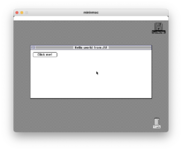flexo
Well-known member
Had this idea for a while so over this weekend I've managed to write a quick-and-dirty proof of concept for it - but I want to make sure that there is at least some interest in either helping me develop this or developing apps using this – or if you think my programming privileges should be taken away for even suggesting such an idea.
Elevator pitch:
While programming for older computers can be challenging but fun, sometimes you just want to make an omelet without first having to build a farm and raising the chickens for the eggs yourself. Writing a Toolbox app is pretty hard - you have to basically do everything yourself.
Imagine instead of writing hundreds of lines of code to display a window with a button, you can just do this:
That's RetroScript: a dialect of JavaScript used to create apps. As an added bonus, this app can work in any platform with the runtime supplied - imagine being able to run the exact same code on a Macintosh SE and a brand new M2 MacBook.
There would be several ways of running a RetroScript app:
I've already written a proof of concept using Retro68 + Duktape, so the first code example provided (sans control callbacks) actually works:

Let me know what you think - if there is enough interest I'll push this as far as I can before cleaning it up and putting it on Github.
Elevator pitch:
While programming for older computers can be challenging but fun, sometimes you just want to make an omelet without first having to build a farm and raising the chickens for the eggs yourself. Writing a Toolbox app is pretty hard - you have to basically do everything yourself.
Imagine instead of writing hundreds of lines of code to display a window with a button, you can just do this:
JavaScript:
var my_window = new RSWindow(500, 200);
my_window.title = "Hello world from JS!";
my_window.center();
var my_button = new RSButton(10, 10, 100, 20);
my_button.text = "Click me!";
my_button.on("click", function(e) {
alert("Thanks for clicking me!");
});
my_window.add(my_button);
my_button.show();
my_window.show();That's RetroScript: a dialect of JavaScript used to create apps. As an added bonus, this app can work in any platform with the runtime supplied - imagine being able to run the exact same code on a Macintosh SE and a brand new M2 MacBook.
There would be several ways of running a RetroScript app:
- Packaged: Your code + RetroScript runtime is packed into a single executable. Perfect for distribution.
- Using the "RetroScript Runtime" application
- Locally: Double-click a RetroScript file and the runtime app launches, running the app. Perfect for developing/debugging personal apps.
- Remotely: Enter a URL and the Runtime fetches and runs the app. Perfect for network apps.
I've already written a proof of concept using Retro68 + Duktape, so the first code example provided (sans control callbacks) actually works:

Let me know what you think - if there is enough interest I'll push this as far as I can before cleaning it up and putting it on Github.
